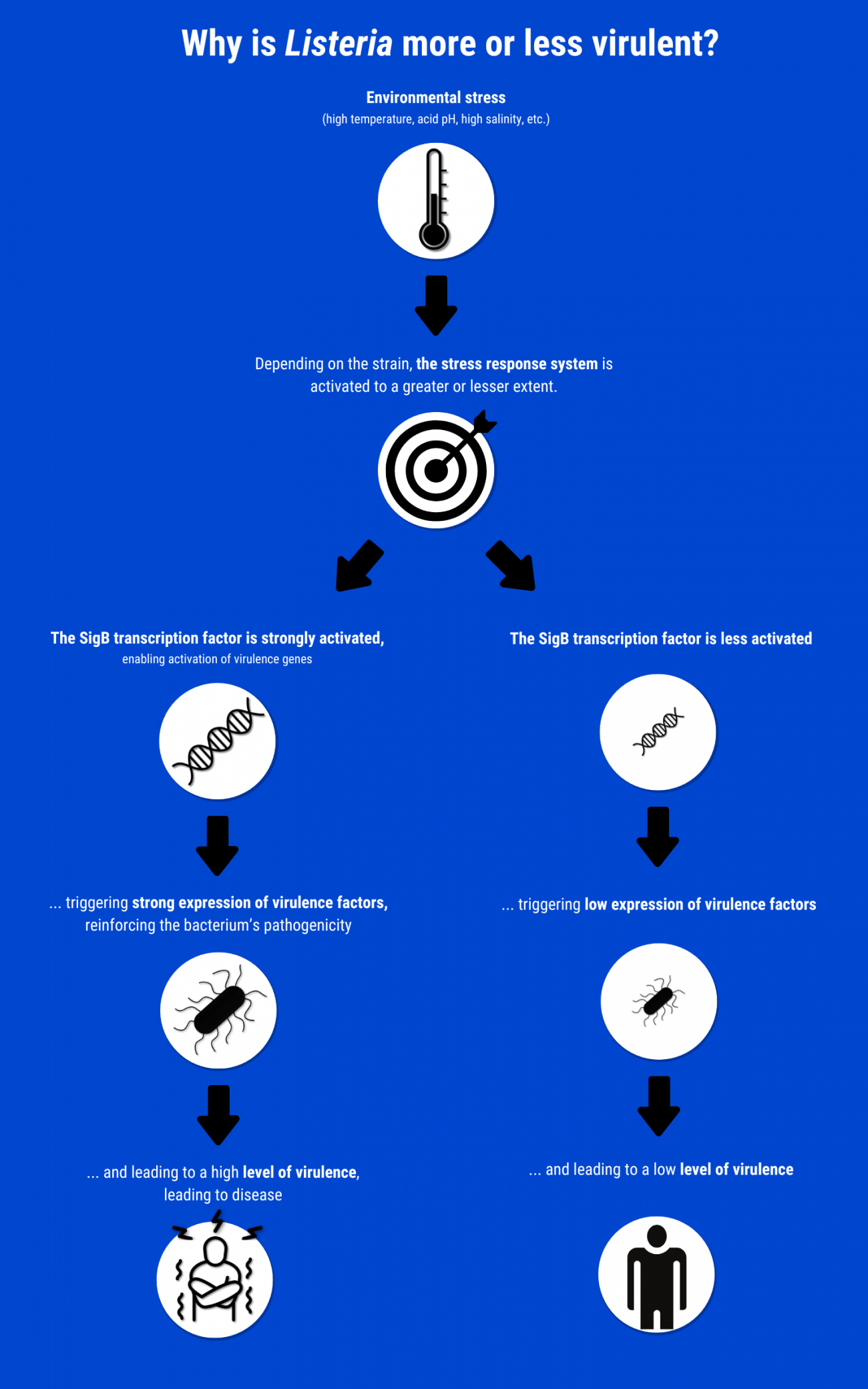The bacterium Listeria monocytogenes can be pathogenic to humans and cause listeriosis, a potentially fatal infection. Until now, the variability in the pathogenicity of Listeria monocytogenes was not clearly understood. But a team from the Institut Pasteur has recently shed new light on a new mechanism that determines virulence by regulating gene expression.
Listeria monocytogenes mainly contaminates animal products, especially dairy products, as well as badly washed, undercooked or poorly stored vegetables. Humans who eat these products can contract listeriosis, a severe and potentially fatal infection. In France, more than 500 people are affected by Listeria infection every year – mainly pregnant women, newborn infants, elderly people or immunocompromised individuals (for example those with cancer, diabetes or HIV or undergoing immunosuppressive treatment).
See our fact sheet Listeriosis: symptoms, treatment, prevention – Institut Pasteur
But "not all strains have the same degree of pathogenicity, as virulence considerably within this bacterial species", explains Marc Lecuit, Head of the Biology of Infection Unit at the Institut Pasteur (Unit also affiliated to Inserm - U1117), the National Reference Center (CNR) and WHO Collaborating Center (WHOCC) for Listeria and coordinator of the study. "Listeria monocytogenes is found in a great number of ecological niches, and it adapts to these different environments. The animal host is one of the most important niches of this bacterial species." In the Biology of Infection Unit, microbiologist Lukas Hafner studied the mechanisms underlying this heterogeneity in virulence as part of his PhD. It was known that virulence is linked to genetic factors – it depends on so-called "virulence genes". While it was thought that virulence was mainly determined by the presence or absence of these genes in a given genome, the team showed that it is more complicated than that...
Greater sensitivity, greater strength
"What primarily determines the heterogeneity of virulence within the Listeria monocytogenes species is not the presence or absence of virulence genes – since they are extremely conserved and can be found in almost all Listeria monocytogenes genomes –, but their level of expression," explains Lukas Hafner. The genes are more or less "active": their level of expression can be low or high. And it is this variation in the level of expression of virulence genes from one strain to another that explains the considerable variability in pathogenicity, even between bacterial isolates that are genetically very close.
But in that case, what determines the differential expression of virulence genes? To understand the differential regulation of virulence gene expression, we need to move up a level in the bacterial mechanism: "It depends on the bacteria's sensitivity to stress." Higher temperatures, significant acidity or salinity are stress factors for Listeria. "The more sensitive the bacteria are to these changes, the faster they will respond to them. This ultimately leads to faster and stronger expression of virulence genes (see diagram below)." And the expression of these virulence factors then enables Listeria monocytogenes to cross the host’s intestinal barrier more effectively and spread more widely throughout the body, by evading the immune system.

The novelty of this study is the discovery of an unexpected, general mechanism that explains the heterogeneity of virulence within a bacterial species at an unprecedented resolution. It should enable a more precise identification of the ecological niches that select for virulence, particularly in farm animals, and pave the way for better prevention. In the Listeria CNR hosted at the Institut Pasteur, this research should lead to more detailed characterization of the Listeria strains collected under the national surveillance system. Currently, as soon as a Listeria strain arrives at the CNR, its genome is sequenced, which provides an initial assessment of how dangerous it is. "Our research into the contribution of the level of expression of virulence genes to virulence will soon enable us to characterize them in more detail, and thus thereby help to prevent this serious infection," concludes Marc Lecuit. Based on this research, a new test to measure the level of expression of virulence genes and thus virulence is currently under investigation.
Source :
Differential stress responsiveness determines intraspecies virulence heterogeneity and host adaptation in Listeria monocytogenes, Nature Microbiology, December 9, 2024
doi: 10.1038/s41564-024-01859-8.


